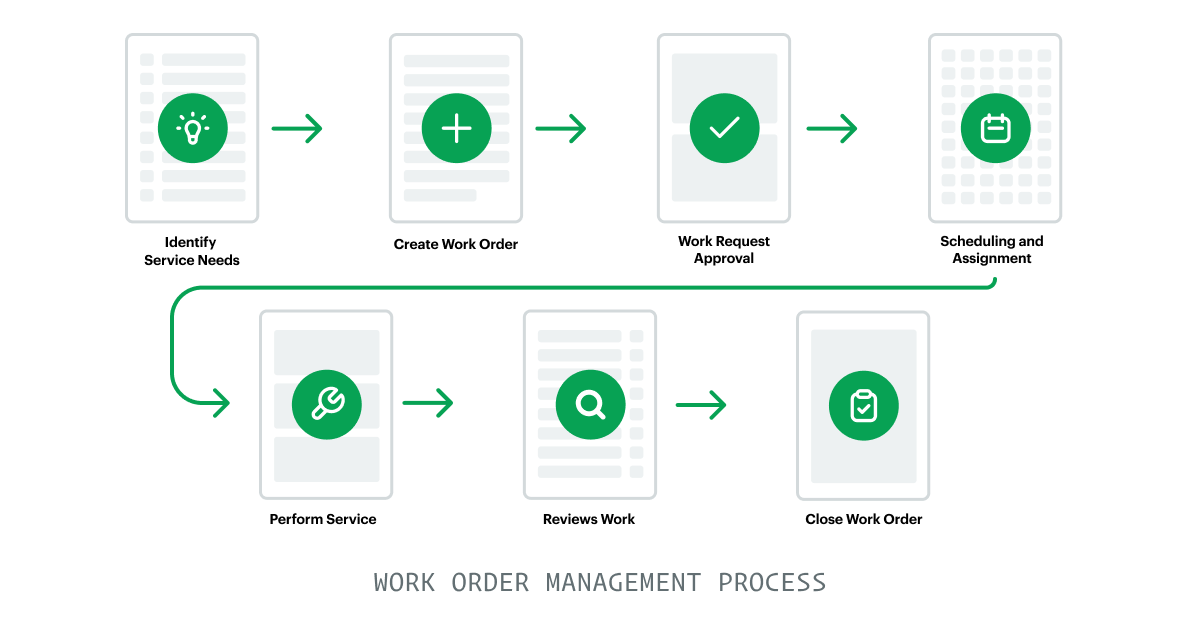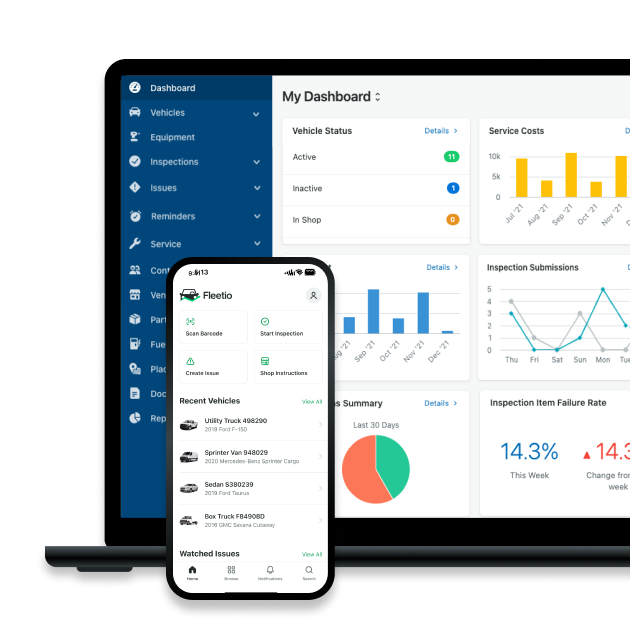Process, Benefits and Solutions for Work Order Management
Manually tracking work orders through paper documents and spreadsheets can throw a wrench in service workflows. Digital work order management with software solutions help fleets improve workflow processes and collect reliable data in real time.
Mar 27, 2024
11 min read

What is Work Order Management?
Work order management is the system or method used to track service tasks from creation to completion. Work orders are a foundational source of documentation and direction for requested, approved and completed service tasks and also hold a wealth of beneficial service data that can better help you understand the health of your fleet.
Work order management can be handled in several ways, including using manual or automated methods. While manual work order management is a perfectly acceptable route, automated work order management through fleet management software (FMS) and other fleet solutions ensures more robust data collection and workflow management for more granular reporting and seamless workflows.
In this Article
Benefits of Work Order Management
The Work Order Management Process in 7 Steps
How Work Order Software Simplifies Management
Prioritize Good Work Order Management with Fleetio
Benefits of Work Order Management
The benefits of work order management depend largely on the process used, and the impact work order data can have varies depending on what information is collected. Most work orders have your basic line items — vehicle information, service completed, date of service and all associated costs — but there are additional line items and pertinent data points you can add to work orders to ensure you’re getting all the data you need to surface and source costly issues and process inefficiencies. For instance, including a line item for repair priority class helps fleets more accurately understand their scheduled, non-scheduled and emergency service spend to easily break down where a majority of the service budget is being used.
Additionally, you can include work order items such as technician assignment and custom labels. Technician assignment provides increased accountability and is helpful in determining technician productivity, allowing fleets to get a better idea of how well distributed service workloads are to reduce chances of frustration and employee disengagement in the shop. Labels, on the other hand, work as an internal way to further organize service based on criteria of your choosing. You can use labels to break down service by asset type, acquisition year and/or by location for fleets with multiple shop locations. You can also use labels to establish reasons for service delays, such as waiting on parts or waiting on an open technician.
Fleets can also take advantage of work order management to:
- Improve task-oriented and team-wide communication for decreased downtime
- Increase workflow efficiency for improved productivity
- Improve in-house parts inventory management for decreased downtime related to parts acquisitions delays
- Gain more accurate data around service duration versus active time on the job to surface process issues that could be costing your fleet both time and money
Why Wait?
Investing in fleet software can be a big decision, but our work order template is a great way to get a jump start on improving work order management!
While fleets using paper forms and spreadsheets can benefit from work order management, consolidating the data for analysis can be a bit time consuming and can lead to erroneous data input. Using FMS or other work order software, fleets can automatically track and consolidate work order data to minimize errors and improve reporting.
The Work Order Management Process in 7 Steps
While work order management can be a flexible process depending on your fleet’s needs, there are a few core steps to consider that directly affect workflow and service data. Below are seven steps to help improve work order management in your fleet.

1. Identify Tasks
Whether an asset throws a DTC alert, a daily vehicle inspection surfaces an issue or you’re just working through some basic preventive maintenance (PM), identifying what tasks need to be added to a work order is the first step in managing the process.
2. Create Work Order
Once service tasks for an asset are identified, create a work order with any necessary information. If you’re using FMS or other fleet software that consolidates service information, you’ll automatically be alerted of any additional services the asset in question may have coming up, such as routine PM. Adding impending service to a work order at this stage decreases downtime associated with having to bring the asset into the shop multiple times.
3. Work Request Approval
After generating a work order, service must be approved by the appropriate party. This not only helps to ensure everyone is on the same page about what work needs to be done, but also provides the reviewer a chance to order any needed parts, cutting shop delays.
4. Scheduling and Assignment
With clear direction about what service tasks need to be done and with, presumably, parts at the ready, work can be scheduled and a technician assigned to the job. Proper scheduling and assignment are crucial to a smooth service workflow, as overscheduling and overbooking technicians creates service delays, as well as employee frustration — both for the technician and the driver waiting on the vehicle.
5. Complete Work
Pretty self-explanatory, this step is all about getting the job done. The assigned technician completes work order tasks and documents any issues they see over the course of service that may not have been included on the work order. This is a great way to tackle issues early to reduce downtime and service spend.
6. Review Work
Reviewing completed work helps ensure that assets released back into the wild — or to their driver — are safe and running optimally. Reviewing work completed before closing the work order affords managers the opportunity to catch missing or poorly executed work so it can be addressed without having to reopen a work order (negatively impacting data accuracy) or create a new work order to correct the issue. This step also allows any issues surfaced over the course of service and identified by the assigned tech to be addressed.
7. Close Work Order
Once all tasks on a work order are completed and reviewed, the work order can be closed, and the technician assigned to the job can move on to the next one. It’s good practice to communicate with your team about who has the authority to close work orders and when, whether that includes the technician assigned, the lead tech, the fleet manager or some other dedicated person. This helps with oversight, as well as with data continuity and accuracy.
Work Smarter
Make the most of your time by using digital work orders in Fleetio to streamline maintenance management.
Learn moreHow Work Order Software Simplifies Management
Automotive work order software and fleet solutions like FMS with work order management features help fleets efficiently organize and streamline end-to-end work order management. Automation is among the many benefits of work order software. Automated service workflows make it easier for fleets to stay proactive with regular maintenance using PM schedules, which can be tailored to specific assets or created in bulk for similar asset types. When an asset nears its PM interval, the software sends a due soon alert so service can be scheduled in advance to minimize downtime.
Drivers can also use the software’s native app to submit digital asset inspections in real time. Failed inspection items alert managers, kicking off the service workflow. This better allows drivers in the field to easily communicate asset health data and ensures the concerns they kick up are addressed.
Once an asset issue is identified, fleets can use the software’s digital work orders to assign work orders to specific technicians who can then use the mobile app to view, comment in and clock in/out of jobs. This provides an organized way for managers to see not only what work was performed, but also whether additional work was suggested based on the technician’s findings.
Consolidating task-oriented communication not only improves visibility of that communication, it also strengthens assets’ service history data so that in the event the asset has a recurring issue or break down, you can easily see if it was avoidable based on service recommendations from the technician. Additionally, all service-related data is captured by the software automatically and aggregated into easy to analyze reports.
Check out digital work orders in Fleetio
Prioritize Good Work Order Management with Fleetio
Fleetio helps simplify work order management for better insights into fleet health and service processes and automates data collection for more uniform reporting. This includes sensor data, powered by telematics, which fleets can use to proactively tackle issues. You can take snapshots of sensor data associated with a fault or irregularity and attach snapshots to associated work orders so technicians can quickly and easily diagnose problems.
Digital work orders in Fleetio track service every step of the way via work order status updates, including open, pending, completed, needs approval or approved. They also include customizable labels so you can go as in-depth as you want — even stacking several labels — for more precise insights. This comes in handy when determining inefficiencies in the shop. For instance, if a work order status is pending and it has been labeled waiting on parts, there could be an issue around in-house parts stocking.
Speaking of, for fleets with in-house parts inventories, adding a part to a work order automatically updates your inventory, and you can set low-stock thresholds to ensure parts are reordered as needed to avoid part-related shop delays. You can save even more time by linking parts to associated service tasks to enable automatic population of those parts on work orders. And, Fleetio offers parts inventory valuation options for more accurate service cost reporting.
Fleets can use service reminders in Fleetio to stay on top of upcoming scheduled services, including setting reminders to be sent to anyone who needs to see them, such as account admins and managers, as well as the driver to whom the asset is assigned and the technician to whom the work order is assigned. Using service reminders not only makes it easier to cleanly schedule service-related downtime, it also ensures everyone in the workflow knows when to be where, why, what’s being done and when an asset is ready for pickup.
When it comes to scheduling service effectively, Fleetio’s Work Order Calendar can help with that. The calendar lays out a complete view of scheduled service tasks and their status, as well as the assigned technician, and can even be filtered down to a single technician’s service tasks by hour, week and month. Having this data all in one place helps fleets make strategic scheduling decisions for workload balance and increased uptime, while capturing actual versus scheduled start and completion dates for a better understanding of the rate and reasons for delays.
Through Fleetio’s automated data collection, consolidation and aggregation — in addition to configurable reporting — fleets can quickly and easily find and address sources of process inefficiencies and inflated spend while improving work order management.
Give it a Spin
Ready to streamline service workflows and gain deeper insights into your fleet’s service spend? Take Fleetio for a test drive today!
Start your trialFAQs
How do you manage work orders?
First, identify any issues or tasks that need to be taken care of. Next, create a work order and wait for work request approval. Once a work order has been approved, schedule the work and assign it to a technician. After the technician completes the job, the work order can be closed and you can review the work.
What is a work order management system?
Work order management is the system or method used to track service tasks from creation to completion. Work order management can be handled in several ways, including using manual or automated methods.
What should a work order contain?
Work orders should always contain information pertaining to the task and costs, including vehicle information, service completed, date of service and parts used. For more granular fleet service data, work orders can also include repair priority class (denoting scheduled versus unscheduled service), time of asset drop off, time of asset pickup, active labor hours (time actually spent on the task from beginning to end), technician assignment and even parts brand and vendor.
What are the main approaches in work order management?
Manually tracking and managing work orders is a common method for work order management; however, automated work order management using fleet management software (FMS) and other fleet solutions ensures more robust data collection and workflow management for more granular reporting and seamless workflows.

Senior Fleet Content Specialist
As a Senior Fleet Content Specialist at Fleetio, Rachael Plant uses her near decade of industry experience to craft practical content aimed at helping fleet professionals tackle everyday challenges with confidence.
LinkedIn|View articles by Rachael PlantReady to get started?
Join thousands of satisfied customers using Fleetio
Questions? Call us at 1-800-975-5304
Get Our Newsletter
Join a community of 70,000+ fleet industry professionals.


